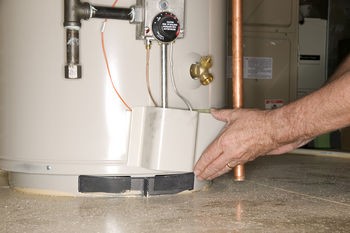Water heaters are a major source of household flooding.
 If you have discovered bad odors coming from your water; smells like sulfur or rotten eggs, it could be bacteria inside the hot water heaters holding tank.
If you have discovered bad odors coming from your water; smells like sulfur or rotten eggs, it could be bacteria inside the hot water heaters holding tank.
In time, your heating unit can collect this sediment consisting of sand, gravel, grit, and different mineral deposits. This accumulation can decrease the amount your water heaters holds, develop a variety of interesting sounds, and lower the effectiveness of your unit. The accumulation of sediment at the bottom can solidify and sometimes block the drain valve.
Pipes, valves and connections wear out and cause leaks. Since water heaters are seldom observed and often hidden or at least out of the way, these can go unnoticed for quite some time.
Sludge can build up in the bottom of your water heater. This can trigger an increase in pressure– and increase your energy expenditure as it ends up being more ineffective. Flushing your water heater once a year can prolong it’s life.
Avoid this from happening by flushing your water heater at least once a year following the manufacturer’s guidelines.
When draining a hot water heater, attach a garden hose to the unit, turn the vent line and lead the water outside the home.
If you don’t know how to do this, call an expert!
Try turning the water heater thermostat down a couple degrees. Probably, you won’t discover the temperature level distinction, and it will save you energy and decrease the pressure in the tank to additionally prevent the possibility of a burst.
If your water heater is more than 10 years old, change it.
If you need to change your water heater don’t buy the most inexpensive hot water heaters. You might be conserving cash going in however it will certainly cost you more in energy usage later. If you have really difficult water you may want to flush your system twice a year or consider a water softener. Water softeners can also help with not having to flush the device as typically. Inspect your T&P valve (temperature pressure relief valve) and make certain it’s working. Pull the level and it need to permit hot water to get away. If T & P valve is not working, replace it instantly. Also it’s recommended that the T&P valve ought to be changed about every 3 to 4 years for your security.
Serving San Diego and San Diego County for over 30 years with quality work and great service. We also service these cities – Chula Vista, El Cajon, La Mesa, Spring Valley, and Lakeside. Poway, Ramona, Alpine, Julian, Santee, Coronado, Imperial Beach, Pacific Beach, La Jolla, University City, Tierrasanta, Rancho Penasquitos, Rancho Bernardo, Rancho Santa Fe, Encinitas, Del Mar, Solana Beach, Leucadia, Sorrento Valley, Miramar, Mira Mesa, Scripps Ranch, Vista, Carlsbad, Oceanside, San Marcos, Lemon Grove, Bonita, Valley Center, Borrego Springs, Escondido, Fairbanks Ranch, Rancho San Diego 4S Ranch, Sabre Springs and Pine Valley.









Follow Us!